Exploring the Design: Minimalist vs Maximalist Interior Design
Interior design is more than just arranging furniture and picking colors; it’s an art form that can dramatically influence the ambiance and functionality of a space. Among the myriad of design philosophies, two stand out as polar opposites: minimalist and maximalist design. In this article, we delve into the world of interior design, examining the principles, characteristics, and merits of both minimalist and maximalist approaches.
Minimalist vs Maximalist Design
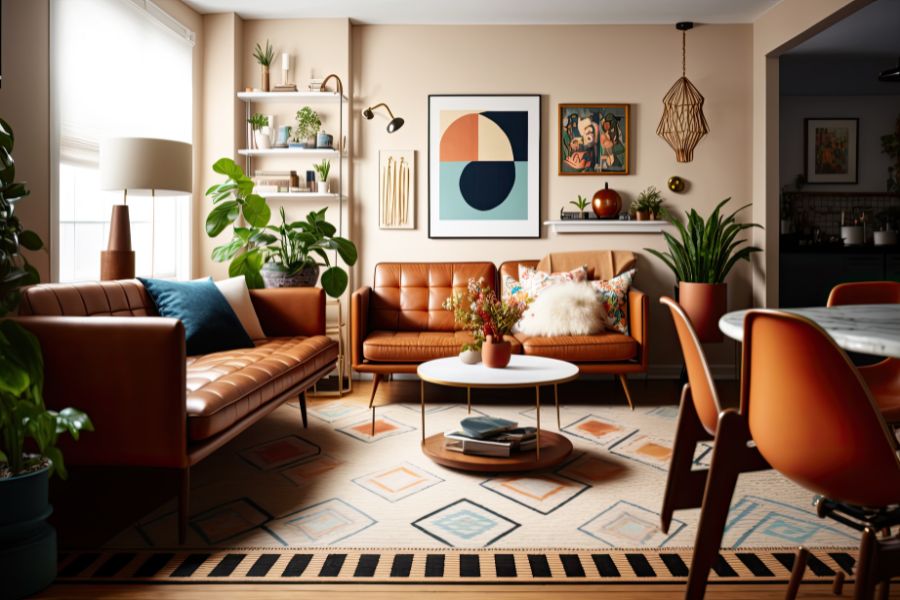
When it comes to interior design, there are two main styles: minimalist and maximalist.
Minimalist Interior Design:
Minimalist design is all about simplicity, functionality, and focusing on the essentials. It’s about using clean lines, open spaces, and keeping ornamentation to a minimum. In a minimalist interior, every item has a purpose, and there’s a sense of calm and tranquility.
Maximalist Interior Design:
maximalist design is the complete opposite. It’s all about abundance, extravagance, and mixing different styles and elements. Maximalist interiors are vibrant, colorful, and full of personality. They’re like a visual feast for the eyes, with layers of textures, patterns, and ornamentation.
What is Minimalist Interior Design?
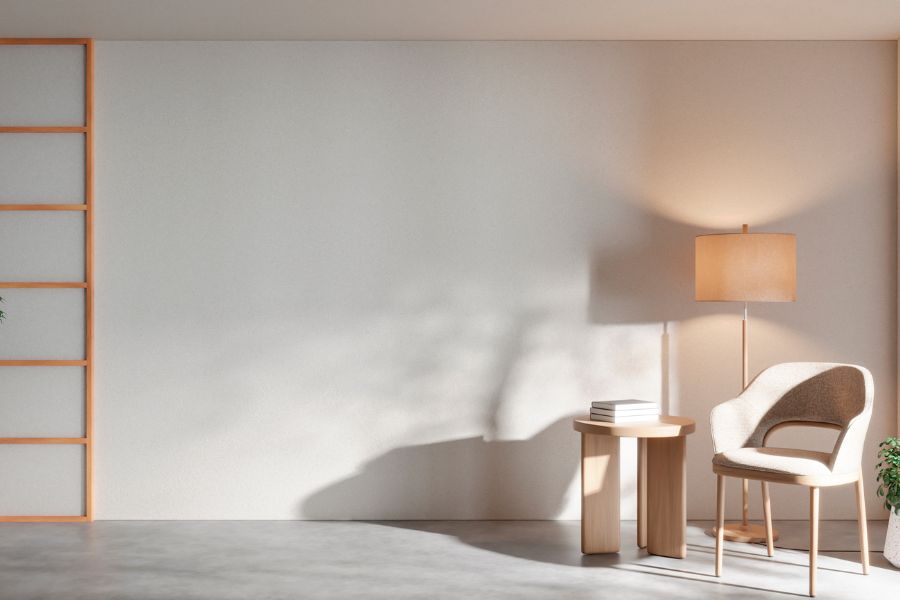
Minimalist interior design is a concept characterized by simplicity, clean lines, and a focus on functionality. It emerged in the 20th century as a reaction against excessive consumerism, aiming to create tranquil, uncluttered spaces that evoke calmness and serenity. At its core, minimalist design emphasizes the notion that less is more, encouraging the removal of unnecessary elements to highlight essential features.
Characteristics of Minimalist Interior Design
Clean lines and clutter-free spaces: Minimalist interiors feature a clean, uncluttered aesthetic, with straight lines and simple geometric shapes. Furniture and architectural elements are sleek and devoid of ornamentation, promoting visual clarity and order.
Minimal furniture and accessories: In minimalist design, every piece serves a purpose, avoiding excess furniture and decor. Spaces are carefully curated to include only essential items, focusing on functionality and practicality.
Neutral color palette with occasional pops of color: Minimalist interiors typically use neutral colors like white, beige, or gray as a backdrop, with occasional pops of color for visual interest and contrast.
Minimalist Interior Design Ideas
Decluttering and simplifying existing spaces: Achieving a minimalist interior starts with decluttering and simplifying existing spaces, removing unnecessary items and creating openness.
Incorporating multifunctional furniture: Multifunctional furniture is essential for versatility and efficiency in minimalist design, maximizing functionality without sacrificing style.
Maximizing natural light and open space: Natural light enhances the sense of openness and airiness in minimalist interiors, achieved through large windows, skylights, and mirrors.
Minimalist Interior Design Materials
Natural materials like wood, stone, and metal: Minimalist interiors often use natural materials in design for warmth, texture, and visual interest, contributing to harmony and balance.
Simple, streamlined fabrics and textiles: Fabrics in minimalist interiors are understated, with an emphasis on clean lines and minimal embellishments.
Minimalist Interior Design Color Palette
Predominantly white, beige, or gray: Neutral tones dominate minimalist interiors, creating a serene atmosphere.
Accents of black or muted tones: Darker hues are used sparingly to add depth and contrast.
What is Maximalism in Interior Design?
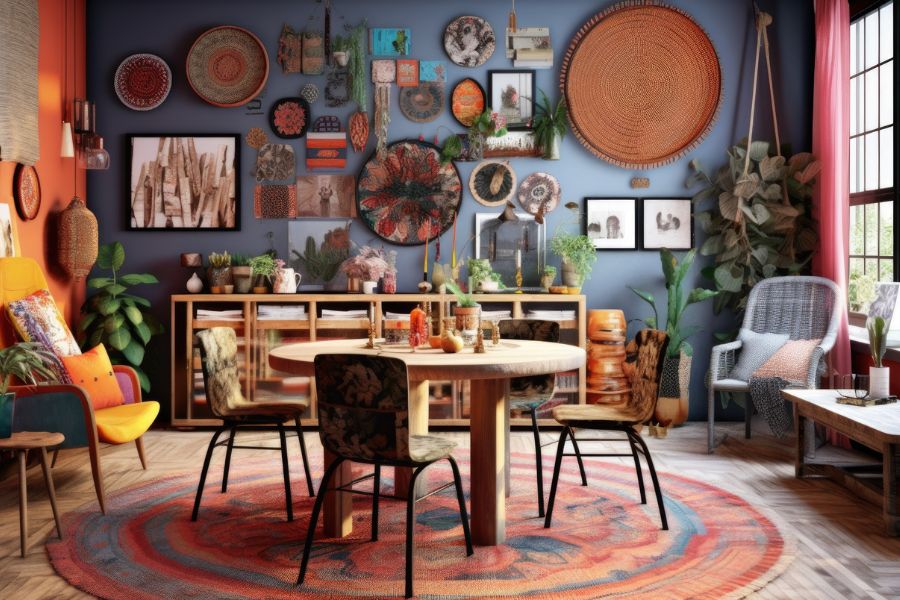
Maximalism in interior design is all about going big and bold with patterns, textures, colors, and decor elements. It’s the opposite of minimalist design, which focuses on keeping things simple and clutter-free. Instead, maximalism embraces the idea of more is more, creating spaces that are visually rich and full of personality.
Characteristics of Maximalist Interior Design:
Bold Patterns, Textures, and Colors: Maximalist Interior Design spaces are filled with eye-catching patterns like florals, stripes, and geometric designs, along with a mix of textures such as velvet, silk, and faux fur. Vibrant colors take center stage, and there’s no fear in mixing different hues to create a visually stimulating environment.
Eclectic Mix of Furniture and Decor: Maximalism loves to mix and match different styles, eras, and cultural influences. You’ll find antique furniture coexisting with modern pieces, creating a dynamic and eclectic vibe in the space.
Layered and Visually Stimulating Spaces: Layers are key in maximalist interior design, with textiles, rugs, and accessories adding depth and dimension to the room. The overall effect is a visually rich and diverse space that encourages exploration and discovery.
Modern Maximalist Interior Design Trends:
Mixing Different Design Styles and Eras: Modern maximalism embraces the idea of blending various design styles and historical periods to create a curated yet cohesive look. You might see mid-century modern elements paired with baroque accents for an interesting juxtaposition.
Incorporating Maximalist Elements in Small Doses: While maximalism is often associated with grandeur, modern interpretations allow for incorporating maximalist interior design elements in smaller spaces. Statement pieces, vibrant artwork, and luxurious textiles can add a touch of maximalist flair without overwhelming the room.
Maximalist Interior Decor Ideas:
Statement Pieces and Art Installations: Maximalist interior design often features statement furniture pieces and oversized art installations that serve as focal points. Sculptural lighting fixtures and bold wall murals add drama and personality to the space.
Vibrant Colors and Intricate Patterns: Bold colors like emerald green, sapphire blue, and ruby red infuse energy into the space. Intricate patterns through wallpaper, upholstery, and decorative accents add depth and visual interest.
Utilization of Space in Maximalist Design: Maximalist interior design makes the most of every inch of space by filling rooms with art, collectibles, and accessories. Verticality is embraced with floor-to-ceiling bookshelves, gallery walls, and statement curtains to maximize visual impact and space utilization.
Difference Between Minimalist and Maximalist Interior Design
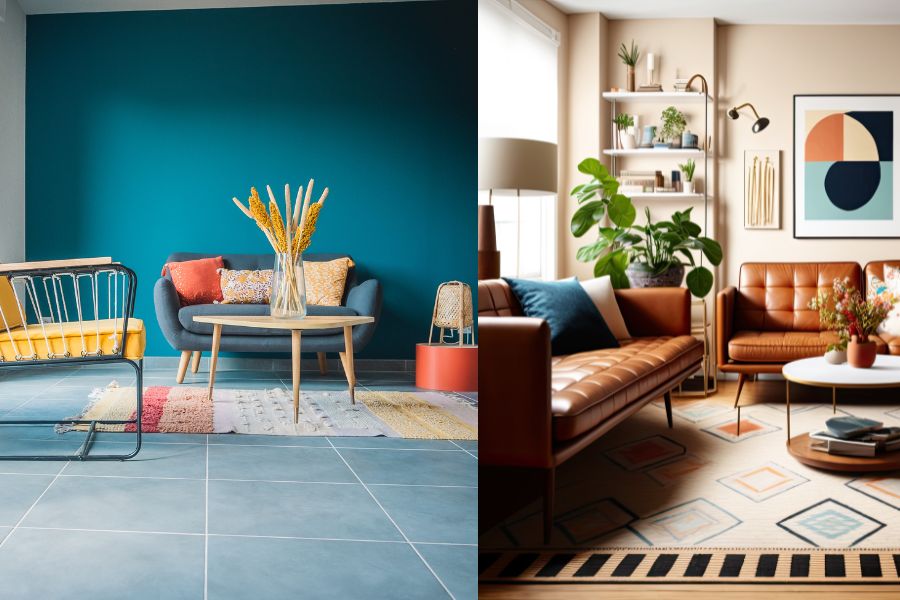
Direct Comparison of Key Elements:
Minimalist Design: When it comes to minimalist vs maximalist interior design, minimalist interiors keep things simple. They focus on clean lines and avoiding clutter. The idea is “less is more,” so furniture and decor are kept to the essentials, with plenty of negative space.
Maximalist Design: On the other hand, maximalist interior design is all about abundance. They embrace bold colors, intricate patterns, and lots of decor items. Every surface is adorned with textures and ornaments, creating a visually rich and dynamic space.
Space Utilization:
Minimalist Design: Minimalist interiors prioritize open space and minimal furniture arrangements. This creates an uncluttered and spacious environment, often with multifunctional furniture pieces.
Maximalist Design: Maximalist interiors make use of every inch of space, incorporating numerous furniture pieces and decor items. There’s a sense of density and richness in the arrangement of objects.
Color Palette:
Minimalist Design: Minimalist interiors typically stick to a neutral color palette, like white, beige, or gray. This enhances the sense of simplicity and tranquility, with occasional accents of color for visual interest.
Maximalist Design: Maximalist interior design embraces vibrant colors and bold patterns, with no strict rules. Contrasting hues and extravagant combinations create a lively and energetic atmosphere.
Furniture and Decor Choices:
Minimalist Design: Minimalist interiors feature sleek and understated furniture with clean lines and minimal ornamentation. Decor items are carefully curated for functionality and minimalistic aesthetics.
Maximalist Design: Maximalist interiors showcase a diverse range of furniture styles and decor items, mixing textures, materials, and design motifs. Ornate pieces and decorative accents add layers of visual interest.
Impact on Mood and Atmosphere:
Minimalist Design: Minimalist interiors evoke a sense of serenity, calmness, and mindfulness. The focus on simplicity promotes a tranquil atmosphere, perfect for relaxation.
Maximalist Design: Maximalist interiors exude energy, warmth, and creativity. The abundance of colors and textures creates a dynamic and vibrant ambiance, encouraging exploration and expression.
Overall, when considering minimalist vs maximalist interior design, it’s all about personal preference and the atmosphere you want to create in your space.
Interior Design Case Studies
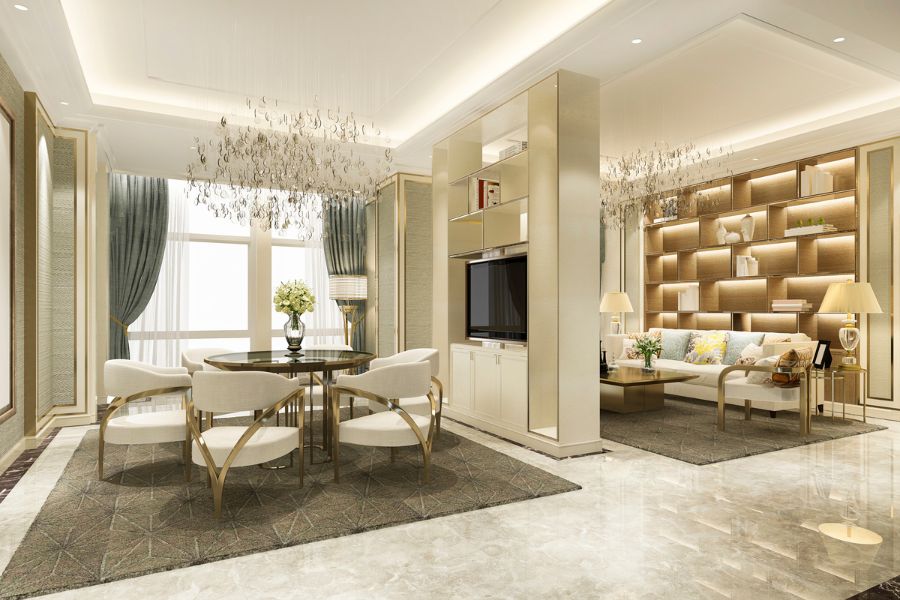
Minimalist Interior Design Case Study: Scandinavian Minimalism Real-life Example: I recently visited an apartment that perfectly exemplifies Scandinavian Minimalism. The space features clean lines, a neutral color palette, and minimalistic furniture pieces. Analysis: The use of natural materials like wood and stone adds warmth and coziness to the design while keeping it simple and uncluttered. One challenge that may arise is striking a balance between functionality and aesthetics, especially in smaller spaces.
Maximalist Interior Design Case Study: Bohemian Chic Real-life Example: I also had the chance to explore a living room that showcases Bohemian Chic design. It’s filled with bold colors, layered textures, and an eclectic mix of furniture and decor. Analysis: The abundance of patterns and decorative elements creates a visually stimulating environment brimming with personality and charm. However, managing clutter and maintaining visual coherence can pose challenges in maximalist design.
In both cases, the contrast between minimalist vs maximalist interior design is evident. While Scandinavian Minimalism focuses on simplicity and clean lines, Bohemian Chic embraces boldness and eclecticism. Each style offers its own unique appeal and challenges.
Lasting Impressions
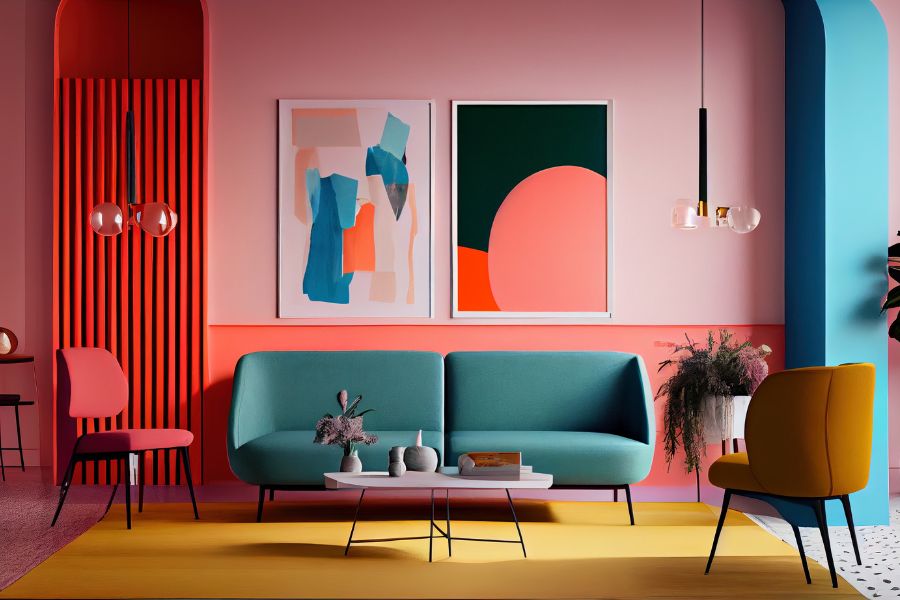
At Interior Designing Firm, Studio A recognizes the ongoing discourse surrounding minimalist vs maximalist interior design. We understand that there’s no definitive answer, only the individual tastes and preferences of our clients. Whether you’re drawn to the serene elegance of minimalism or the dynamic vibrancy of maximalism, our team is here to bring your vision to life. Our goal is to design spaces that authentically reflect your personality, complement your lifestyle, and evoke a sense of joy. So, whether you align with the minimalist camp or the maximalist camp, we encourage you to embrace your style and let us help you create a space that feels uniquely yours.
FAQs: Frequently Asked Questions
What is the difference between minimalist and maximalist interior design?
A. Minimalist interior design focuses on simplicity, clean lines, and minimal clutter, while maximalist design embraces bold patterns, colors, and a layered aesthetic.
How do minimalist and maximalist designs differ in terms of space utilization?
A. Minimalist design often emphasizes open space and minimal furniture, while maximalist design utilizes space more densely with multiple layers of decor and furnishings.
What are some characteristics of minimalist interior design?
A. Minimalist interior design is characterized by clean lines, neutral color palettes, minimal furniture, and a focus on functionality and simplicity.
What materials are commonly used in minimalist interior design?
A. Natural materials such as wood, stone, and metal are often favored in minimalist design for their simplicity and durability.
Maximalist design embraces bold patterns, vibrant colors, and intricate textures, often layering them together to create visually stimulating spaces.
Image Reference: Freepik
Disclaimer: All trademarks, logos, and brand names are the property of their respective owners. All company, product, and service names used in this website are for identification purposes only. Use of these names, trademarks, and brands does not imply endorsement.

